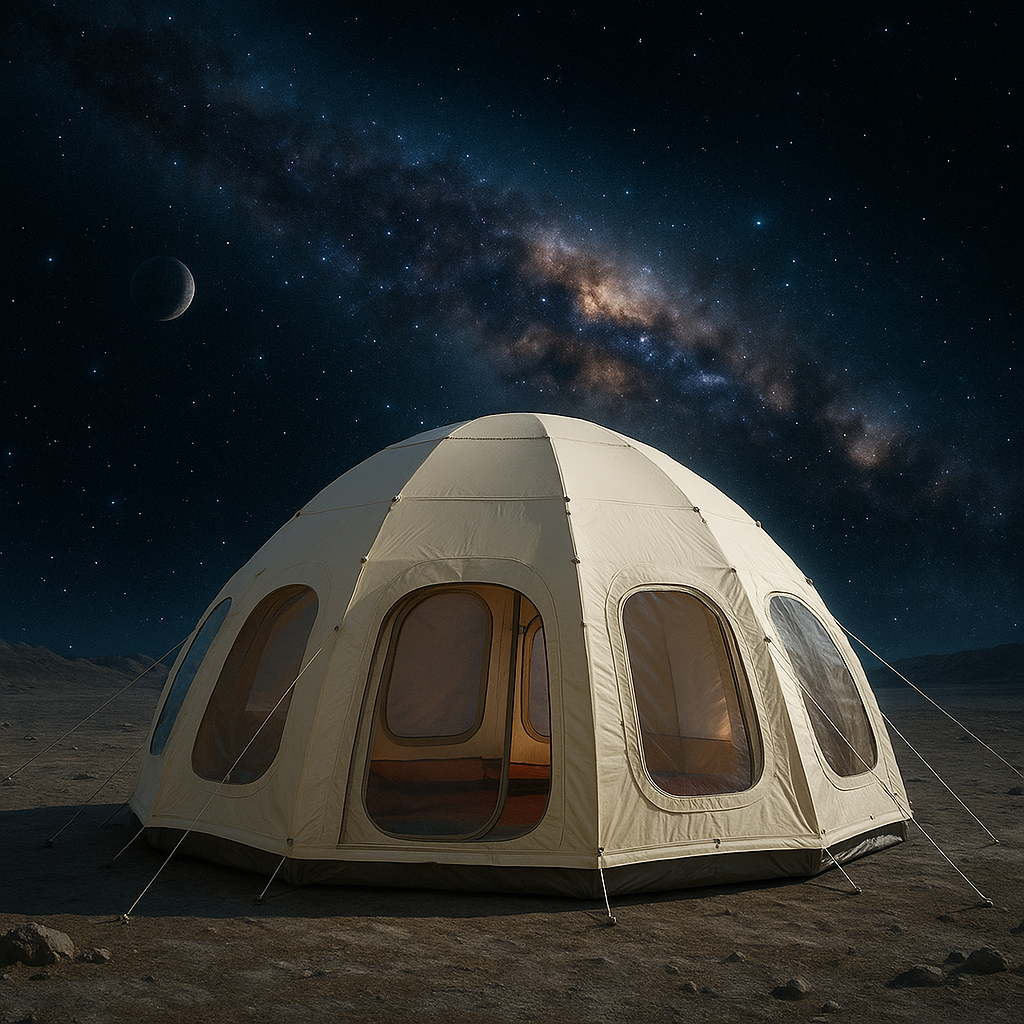
Are Inflatable Tents the Future of Outdoor Living?
Share
Inflatable Tents and the Future of Outdoor Living
Introduction: from Poles to Air Beams
Camping shelters have evolved dramatically over the last century—from heavy canvas supported by wooden poles to ultralight nylon tensioned over aluminum frames. An important leap happened when designers replaced rigid poles with pressurized air beams. Inflatable tents can be pitched in minutes because users simply unfurl the fabric and pump air into robust tubes; there are fewer parts to lose and no fiddly pole sleeves (olproshop.com). These innovations are why many experts believe air‑beam tents are poised to reshape outdoor living. Markets are responding: analysts project that the global inflatable tent market could grow at roughly 7.5 % a year, reaching more than USD 2 billion by 2034 (futuremarketinsights.com).
What Makes Inflatable Tents Special?
Traditional tents rely on rigid poles to create structure, which can make setup time consuming. Inflatable models instead use pressurized air beams that form a self‑supporting frame. This change brings several benefits:
-
Rapid setup and teardown. Many air‑beam tents can be erected in five to ten minutes using a hand pump, eliminating the need to thread poles (olproshop.com). A review in Tread magazine noted that modern inflatable tents “go from flat to full size in minutes,” making them well suited to spontaneous trips (treadmagazine.com).
-
Lightweight and portable. Air tubes weigh less than metal poles, so these tents pack down smaller and can be carried in a single bag (westshade.com). The portability is attractive for hikers, festival‑goers and families.
-
Durable and flexible. High‑quality canvas fabrics coated with polyurethane and reinforced seams make air‑beam tents resistant to punctures and tearing (olproshop.com). Flexibility allows the beams to bend and then return to shape in high winds, providing stability that rigid poles often lack (westshade.com).
-
Improved interior space. Without poles crossing the living area, inflatable tents often feel more spacious. The absence of internal framework makes arranging beds and furniture easier and frees up headroom.
-
Easy maintenance and repairs. Small punctures can be fixed in the field with patch kits similar to bicycle‑tire repair kits (olproshop.com). Some designs integrate modular air beams so damaged sections can be replaced without discarding the whole tent (reanin.com).
These advantages help explain why nearly 40 % of outdoor enthusiasts now prefer inflatable designs (reanin.com). The same study found that about 45 % of consumers prioritise tents made from recyclable materials, underscoring a growing desire for sustainable options (reanin.com).
The Wilderness Resource Approach
Wilderness Resource is a U.S.–based, service‑disabled veteran‑owned company that has embraced air‑beam technology. Their mission is to blend durability, comfort and style, producing tents that serve campers, festival organisers and glampers alike. Two flagship models—the Jellyfish Air Beam Tent and the Galaxy Air Beam Tent—showcase how thoughtful design can elevate the camping experience.
Spotlight: Jellyfish Air Beam Tent
The Jellyfish is Wilderness Resource’s statement piece. This 16‑foot (5 m) diameter dome inflates in about five minutes using high‑pressure PVC air beams. Its body is constructed from 900‑denier PU‑coated Oxford canvas—waterproof, UV‑resistant and tough enough for four‑season camping. A flame‑retardant PVC groundsheet adds peace of mind and easy cleanup.
Key features include eight doors and four windows, all fitted with mesh screens for ventilation and insect protection. Clear TPU panels allow panoramic views, while opaque Oxford panels offer privacy. Climate control is built in: an integrated stove jack accommodates wood stoves for winter warmth, and a dedicated air‑conditioning duct allows campers to thread an AC hose for summer cooling. A zipper port enables safe access for electrical cords so campers can run lights, heaters or devices. Reinforced seams keep the air‑beam frame sealed and secure for long‑term use.
Interior space is where the Jellyfish shines. With a massive 16‑foot diameter and a peak height of 10 feet (3 m), there’s room for multiple beds, lounge areas and even dining furniture. Wilderness Resource markets the tent as glamping‑grade, emphasising that you can decorate and furnish it like a boutique hotel. A family of five to ten people can sleep comfortably with gear inside. The tent’s all‑season performance and ability to house a stove or AC unit make it suitable for year‑round living.
Spotlight: Galaxy Air Beam Tent
The Galaxy is a slightly smaller but equally innovative 13‑foot (4 m) air‑frame tent designed for versatility. Like its sibling, it inflates in minutes using the included pump . The tent features nine transparent skylight panels that flood the interior with natural light and provide unobstructed stargazing. Four oversized mesh‑screened doors (66 × 44 inches) and four large windows (48 × 40 inches) ensure excellent ventilation.
The Galaxy’s air‑beam frame uses rugged 700‑denier PU‑coated canvas ripstop fabric and a heavy‑duty flame‑retardant PVC groundsheet, making it waterproof, UV‑ and mold‑resistant. The integrated stove jack, A/C duct, and electrical cord zipper support all‑season climate control and modern conveniences. Numerous storage pockets keep essentials organized, and a removable star cover can be zipped over the skylights for shade or privacy.
The tent boasts 133 square feet (12.4 m²) of living space, with walls rising to 75 inches (1.9 m) and a centre height of 102 inches (2.6 m). This generous headroom allows campers to stand and move comfortably. Unlike many small tents, the Galaxy can stand without guy‑lines and retains its shape for months without additional inflation (wildernessresource.com). For growing campsites, its modular design allows multiple tents to be connected via an optional tunnel attachment (wildernessresource.com) —perfect for creating multi‑room glamping setups.
Jellyfish vs. Galaxy: Choosing Your Ideal Tent
Both air‑beam models share durable construction, rapid inflation and integrated climate control, yet they serve different needs:
The Jellyfish is the tent of choice if you prioritise maximum space and hotel‑like comfort. The Galaxy offers many of the same conveniences in a more compact, easily expandable package.
Are Inflatable Tents the Future? Market and Industry Insights
Several market reports suggest air‑beam tents are more than a fad. Future Market Insights projects that the inflatable tent market will reach around USD 2.3 billion by 2034, almost doubling from its 2024 value (futuremarketinsights.com). This growth is fuelled by rising disposable income and a preference for luxury camping and glamping experiences. Ecotourism and the desire for low‑impact lodging also drive demand, as inflatable tents leave minimal footprints and set up quickly without damaging vegetation.
Glamping as a whole is booming. Grand View Research estimates the global glamping market at about USD 3.45 billion in 2024 and predicts it will exceed USD 6 billion by 2030, growing roughly 10 % annually (grandviewresearch.com). Tent accommodations specifically are expected to grow at 11.4 % annually because they offer immersive nature experiences and improved features. Industry surveys confirm the sector’s maturity: roughly 75 % of glamping sites have been operating for more than two years, and tents have overtaken cabins as the most common glamping structures (glampingshow.us). Operators are expanding; 22 % now manage multiple locations, up from 2023.
Beyond leisure, inflatable shelters are finding diverse applications. A recent market analysis noted a 30 % uptick in adoption as event organisers seek portable structures for fairs, exhibitions and emergency relief. About 55 % of event planners intend to incorporate inflatable tents, citing quick assembly and ease of transport. Innovations such as advanced coatings and modular construction appear in roughly 35 % of new designs (reanin.com), improving reliability in severe weather. Such statistics suggest air‑beam tents are becoming mainstream across recreational and commercial sectors.
Addressing Common Concerns
Durability and Weather Resistance
A common worry is whether inflatable tents can withstand harsh conditions. Premium models like the Jellyfish and Galaxy use thick canvas fabrics (900D and 700D, respectively) with PU coatings and welded seams. These materials are waterproof, UV‑resistant and designed to endure strong winds. Flexibility allows the air‑beam frames to bend rather than break during gusts (westshade.com). In the rare event of a puncture, patch kits are included, and most repairs can be made on site.
Safety and Interior Comfort
Both Wilderness Resource tents incorporate flame‑retardant groundsheets to reduce fire risk. Stove jacks with heat‑resistant collars allow safe use of wood‑burning stoves during winter, while mesh vents and AC ducts provide ventilation for summer. Secure inflation valves prevent accidental deflation, and emergency deflation is as simple as opening a valve. With integrated zipper ports for electrical cords and storage pockets, campers can charge devices and organise equipment without compromising the tent’s integrity.
Environmental Considerations
Inflatable tents have a lower carbon footprint compared to traditional metal‑poled tents because they use fewer metal components and lighter materials. Their quick setup minimises ground disturbance, and recyclable fabrics appeal to eco‑conscious consumers—nearly half of surveyed buyers prioritise such materials (reanin.com). The reduced weight also cuts shipping emissions, while integrated features (stove jacks, AC ducts, storage pockets) eliminate the need for additional gear.
Tech‑Friendly Camping and Modern Conveniences
As outdoor enthusiasts increasingly rely on technology, tents must support power and climate control. Both the Jellyfish and Galaxy include dedicated ports for electrical cords, letting campers run lights, fans and chargers safely inside. The Galaxy’s skylights and clear windows are ideal for harnessing solar energy, while its star cover can block light for better sleep or privacy. The Jellyfish’s all‑weather ventilation and AC duct ensure comfort in hot climates.
Real‑World Use Cases and Testimonials
User feedback underscores the practicality of inflatable tents. Reviewers of the Jellyfish tent praise its ease of setup (“inflate it once… and you are set”) and remark that it is “half the price of some other brands” while offering exceptional support. Galaxy tent owners appreciate the absence of poles and highlight the joy of watching stars through the skylight—one camper reported staying completely dry during a storm while enjoying views of the clouds and rain above. Such experiences show that air‑beam tents are not only functional but also enhance the connection to nature.
Conclusion: Embrace the Air‑Beam Revolution
Inflatable tents are no longer curiosities. Rapid setup, lightweight construction, impressive durability and integrated amenities make them ideal for campers seeking both comfort and adventure. Market trends show that demand is surging, driven by glamping, eco‑tourism and event applications (futuremarketinsights.com reanin.com). Wilderness Resource’s Jellyfish Air Beam Tent and Galaxy Air Beam Tent exemplify how innovative design can turn a shelter into a luxurious, eco‑friendly home in the wild. For anyone ready to redefine their outdoor experience—whether hosting a festival, running a glampsite or simply camping with family—air‑beam tents offer a glimpse of the future today.
